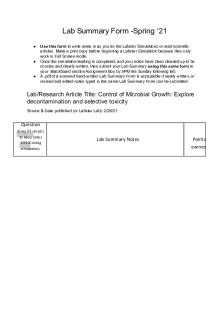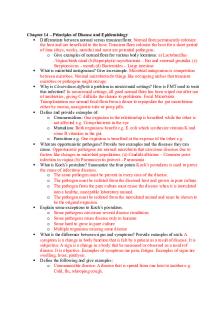Bio 226 Week 2B Ch 7 Control of Microbial Growth PDF

| Title | Bio 226 Week 2B Ch 7 Control of Microbial Growth |
|---|---|
| Author | Madee_laine A |
| Course | Microbiology For Health Professionals |
| Institution | Drexel University |
| Pages | 3 |
| File Size | 87 KB |
| File Type | |
| Total Downloads | 113 |
| Total Views | 175 |
Summary
Download Bio 226 Week 2B Ch 7 Control of Microbial Growth PDF
Description
Bio 226 Week 2B HW Chapter 7 – Control of Microbial Growth
What’s the difference between cleaning, disinfecting & sanitizing? Sterilization: overall destruction of all microorganisms Disinfecting: Destroying of harmful microorganisms Sanitizing: Lower microbial counts to safe public health levels and minimize the chances of disease transmission. Define the following key terms related to microbial control: o Sterilization: Overall destruction of all microorganisms o Disinfection: Destroying of harmful microorganisms o Antisepsis: Use of a disinfectant to treat an inert surface or substance o Degerming: Mechanical removal of microbes (not killing) o Sanitization: Lowering microbial counts to safe public health lvls to minimize the chances of disease transmission. o Asepsis: absence of significant contamination. How do bacterial populations die? They die when their microbial populations are heated or treated with antimicrobial chemicals. o If you started with 103 cells how many cells would there be if there was a one log decrease? 900 What factors influence the effectiveness of antimicrobial treatments? Number of microbes, environment (biofilms & organic matter), Temperature & pH, time of exposure, microbial characteristics. Describe the three mechanisms by which antimicrobial agents work on cells: Alteration of membrane permeability, damage of proteins, damage to the nucleic acid. What’s the difference between TDP, TDT and DRT in relation to microbial control by heat? TDP (Thermal death point): lowest temperature at which all cells in a culture are killed in 10 minutes. TDT (Thermal death time): Time to kill all cells in a culture. DRT (Decimal reduction time: Minutes to kill 90% of a population at a given time. What is the difference between autoclaving and pasteurization? Pasteurization: reduces spoilage organisms and pathogens WHILE Autoclaving: Sterilization by steam and pressure usually at 121 degrees Celsius. What’s the problem with drinking raw milk? Raw milk has bacteria that can be really dangerous to consume resulting in sickness or even death. Compare the effectiveness of moist heat and dry heat: Moist heat kills microorganisms primarily by coagulating proteins (denaturation). Dry heat, microorganisms are killed by oxidation. Describe how filtration, low temperature, pressure, dessication and osmotic pressure suppress microbial growth: Filtration: Passage of liquids through a screenlike material with pores. o Low temperature: The effectiveness varies between microbes, many microbes survive but do not grow at freezing temperatures. o Pressure: High pressure is applied to liquid suspensions is transferred instantly throughout a sample, the pressure inactivates bacterial cells. However, endospores are resistant.
o Dessication: Due to the absence of water microorganisms can’t grow or divide but remain viable. o Osmotic pressure: Use of high concentration of salts and sugars, undergoes plasmolysis What type of radiation is most bactericidal? Ultraviolet Radiation What does it mean if a disinfectant has a phenol coefficient >1? Disinfectant is more effective than phenol. What’s the difference between the disk diffusion and use-dilution methods for evaluating a disinfectant? Disk diffusion measures the efficiency of a disinfectant with an agar diffusion test, determine susceptibility to chemotherapeutic agents WHILE Use-dilution method effectiveness of a disinfectant using serial dilutions. In order from most resistant to least resistant, list the various microorganisms by their ability to be killed. Give two specific examples for each type of microorganism. Most resistant: Prions Endospores bacteria Mycobacteria Cysts of protozoa Vegitative Protozoa Gram-Neg Bacteria Fungi, including most fungi spore forms Viruses without envelopes Gram-positive bacteria Viruses with lipid envelopes For the following chemical disinfectants indicate their mode of action, organisms they can kill, and if they are able to disinfect endospores and mycobacteria. Give a specific example for each type and its use. o Phenols & Phenolics (Carbonic Acid): o Phenol: Irritant & odor, denatures proteins. Ex. 1% in throat sprays, oldest disinfectant. o Phenolics: Lysol (cresols or O-phenylphenol) o Bisphenols: Hexachlorophene, Triclosan (household cleaners), disrupts the plasma membrane. Hexa. Nurseries to control Gram (+), longterm can result in brain damage. Tris. Incorporated into kitchen cutting boards & knifes , inhibits formation of lipids, effective against gram (+) & works on Gram (-) & fungi EXCEPT pseudomonas aeruginosa. o Biguanides: Disrupts plasma membrane, broad spectrum activity. Ex. Avagard (waterless surgical scrub) Strong affinity skin. Resistant to myobacteria, endospores, protozan cyst. o Halogens à bleach, chlorine dioxide, chloramines: Do not stain and are less irritating. Chlorine dioxide, gaseous forms kills enospores & very penetrating. Chloramines (chlorine & ammonia), stable and releases overtime, glassware and untinsels, & water treatments. o Alcohols: Denature proteins and dissolve lipids, Ex. Ethanol & Isopropanoal. 60%-95% effective, not effective against endospores or non-enveloped viruses. o Heavy Metals: Denature proteins, Oligodynamic action, Ex. 1% silver Nitrate in eyes of newborns & burns and dressings.
o Surface Active Agents (Quats): Strongly affective against gram (+). Resistant against pseudomonas, spores, myobacterium, and RGM. Ex. Skin degerming, soap & antisepsis. o Aldehydes: Inactivate the proteins by cross-linking with functional groups. Ex. Cidex, OPA (less irritating) o Gaseous Sterilant: Highly penetrating, denature peoteins. Ex. Ethylene Oxiode (excellent sterilizing agent) o Peroxygens: Oxidizing agents. Ex. O3 disinfection of water, Benzoyl Peroxide. Why is H2O2 said to be a good disinfectant, but a poor antiseptic? H2O2 can inhibit wound healing. What is plasma sterilization and how does it kill microbes? A reliable method for sterilizing things with small diameters in millimeters. It has elements of both chemical and physical sterilization and only requires low temperatures. How effective are the “green” products for disinfection? They’re not disinfectants but rather cleaning agents. Why is alcohol effective against some viruses and not others? Will alcohol work on COVID-19? Alcohol denatures proteins, it can also disrupt membranes and dissolve many lipids, while acting and evaporating quickly. Yes, if it is 70% concentrated. What’s the difference between antibiotics that are bacteriostatic vs those that are bactericidal? Give two examples of each type: Bacteriostatic antibiotics prevent microbes from growing vs. Bactericidal antibiotics kills microbes directly. What is a superinfection? An overgrowth of an opportunistic pathogen when normal flora is killed. What are the major modes of action for antimicrobial drugs? Give two examples for each mode. Inhibition of cell wall synthesis.Ex. Cephalosporins, bacitracin 2. Inhibition of protein synthesis. Ex. Erthromycin, tetracylines. 3. Inhibition of nucleic acid replication. Ex. Quinolones, rifampin 4. Injury to plasma membrane. Ex. Polymyxin B 5. Inhibition of essential metabolic synthesis. Ex. Sulfanimide, trimethoprim. Give two examples of common food preservatives? Where do they come from and what are they used for? o Propionic Acid: Inhibits growth of mold and some bacteria in baked goods and processed cheese. Occurs naturally in things like apples, tea, & violet leaves. Ex. Butter, ice cream, etc. o Sorbic Acid: Used as a preservative in food and drinks to prevent the growth of mold, yeast, & fungi. Can be found in things like cheese, wine, pickles, soups, jelly, etc. A natural compound made synthetically. Why do we need preservatives? What are the pros and cons of artificial vs natural preservatives? Preservatives help increase shelf life allowing products to last longer. Natural Preservative: black pepper, cloves, mustard, cinnamon. Artificial preservatives are synthetic....
Similar Free PDFs

Microbial Control
- 3 Pages

Microbial Growth & Nutrition
- 14 Pages

GDP & Economic Growth Ch.7
- 2 Pages

BIO 226 Chapter 12
- 5 Pages

Ch. 7 bio - Lecture notes 7
- 12 Pages

Lab 6 Control of Microbe Growth
- 3 Pages
Popular Institutions
- Tinajero National High School - Annex
- Politeknik Caltex Riau
- Yokohama City University
- SGT University
- University of Al-Qadisiyah
- Divine Word College of Vigan
- Techniek College Rotterdam
- Universidade de Santiago
- Universiti Teknologi MARA Cawangan Johor Kampus Pasir Gudang
- Poltekkes Kemenkes Yogyakarta
- Baguio City National High School
- Colegio san marcos
- preparatoria uno
- Centro de Bachillerato Tecnológico Industrial y de Servicios No. 107
- Dalian Maritime University
- Quang Trung Secondary School
- Colegio Tecnológico en Informática
- Corporación Regional de Educación Superior
- Grupo CEDVA
- Dar Al Uloom University
- Centro de Estudios Preuniversitarios de la Universidad Nacional de Ingeniería
- 上智大学
- Aakash International School, Nuna Majara
- San Felipe Neri Catholic School
- Kang Chiao International School - New Taipei City
- Misamis Occidental National High School
- Institución Educativa Escuela Normal Juan Ladrilleros
- Kolehiyo ng Pantukan
- Batanes State College
- Instituto Continental
- Sekolah Menengah Kejuruan Kesehatan Kaltara (Tarakan)
- Colegio de La Inmaculada Concepcion - Cebu









